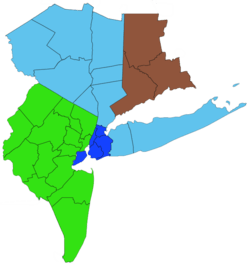Regional Plan Association
 | |
 31-county area[1] | |
| Abbreviation | RPA |
|---|---|
| Formation | 1922 |
| Type | Non-Profit |
| Purpose | Regional planning |
| Headquarters |
Manhattan, New York, |
Region served | New York metropolitan area USA |
President | Thomas K Wright |
Staff | 30 |
| Website |
rpa |
The Regional Plan Association of the United States is an independent, not-for-profit regional planning organization, founded in 1922, that focuses on recommendations to improve the quality of life and economic competitiveness of a 31-county New York–New Jersey–Connecticut region in the New York metropolitan area.[1] Headquartered in New York City, it has offices in Princeton, New Jersey, and Stamford, Connecticut.[2]
Regional plans
RPA has produced four strategic regional plans for the New York metropolitan region since the 1920s. The chronology of their plans is as follows:
- The First Plan in 1929, developed under the leadership of Thomas Adams, provided a guide for the area's road and transportation network.[3]
- The Second Plan, published as a series of reports in the 1960s, aimed at restructuring mass transit and reinvigorating deteriorating urban centers.
- The Third Plan in 1996, "A Region at Risk," recommended improving regional mass transit, increasing protection of open space and maintaining employment in traditional urban centers.
- The Fourth Plan in 2017 suggested improving the area's transportation network, making more affordable housing, implementing measures to fight climate change, and restructure the area's public institutions.[4]
Planning philosophy
The RPA program represents a philosophy of planning described by historian Robert Fishman as "metropolitanism," associated with the Chicago School of Sociology. It promotes large scale, industrial centers and the concentration of population rather than decentralized development. Its critics point out that this results in windfall real estate profits for downtown interests. Whether this approach to regional planning is efficient, particularly because of the infrastructure and energy required to sustain such concentration, has been questioned by scholars including James Howard Kunstler.[3]
Impact in the Tri-state area
Regional Plan Association's strategic plans have proposed numerous ideas and investments for the New York metropolitan area that have turned into major public works, economic development and open space projects, including:
- The location of the George Washington Bridge.[5]
- The preservation of the Palisades and the construction of the Palisades Interstate Parkway.[6]
- The redevelopment of Governors Island, through the RPA-led coalition Governors Island Alliance.[7]
- The establishment of urban national parks like the Gateway National Recreation Area in Jamaica Bay.
- The revitalization of the regional centers like Downtown Brooklyn, Newark, and Stamford.[8]
See also
References
Notes
- 1 2 Danielson & Doig 1982, pp. 35–37.
- ↑ "Contact - Regional Plan Association". Regional Plan Association. Retrieved 7 October 2014.
- 1 2 Fishman 2000, pp. 65–88.
- ↑ "Fourth Regional Plan - Regional Plan Association". Regional Plan Association. Retrieved 30 November 2017.
- ↑ "For Hudson Bridge Above 125th Street". The New York Times. December 28, 1923. Retrieved 7 October 2014.
- ↑ Binnewies, Robert O. (2001). Palisades: 100,000 Acres in 100 Years. Fordham University Press. p. 203. Retrieved 7 October 2014.
- ↑ Governors Island Alliance. "Our Mission".
- ↑ Regional Plan Association. "Shaping the Region". Retrieved 20 October 2014.
Bibliography
- Danielson, Michael N.; Doig, Jameson W. (1982). New York The Politics of Urban Regional Development. Berkeley, California: University of California Press. pp. 1–352. ISBN 0-520-04371-5. OCLC 300399555.
- Fishman, Robert (2000). "Chapter 3: The Metropolitan Tradition in American Planning". In Fishman, Robert. The American Planning Tradition: Culture and Policy. Baltimore: Johns Hopkins University Press. pp. 65–88. ISBN 0-943875-95-1. OCLC 606524089.
Further reading
- Hiss, Tony; Yaro, Robert (1996). A region at risk: the third regional plan for the New York-New Jersey-Connecticut metropolitan area. Washington, D.C.: Island Press. p. 281. ISBN 1-55963-492-8. OCLC 474182259.
- Johnson, David A. (1995). Planning the Great Metropolis: The 1929 regional plan of New York and its environs. London: Routledge. p. 299. ISBN 0-419-19010-4. OCLC 473189260.